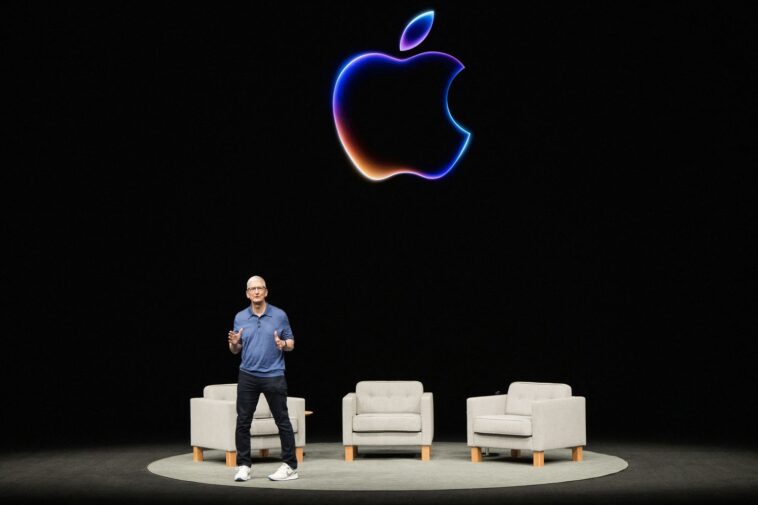Recently, the downward trend in Apple’s stock price paints a noticeably different picture from its steady ascent in 2020, a year that found refuge in this tech stock amid the tumultuous market. It’s important to underline, however, that while Apple may currently be underachieving, it does not negate the tech sector’s appeal to investors. The collective tech sector has rebounded dramatically from the substantial early-year selloff, indicating a powerful recovery. Rather than homing in exclusively on single tech stocks, investors are adopting a diversified approach, increasing their tech involvement through S&P 500 index funds and ETFs, while also revisiting traditionally safer sectors.
Over the years, appealing aspects of tech stocks have made them akin to safe shelters during periods of heightened market volatility, a pattern observed during the unfurling Covid-19 pandemic. Lately, however, a dip in Apple’s stock, typically viewed as one of the safest amongst tech stocks, has thrown into question this established belief. Apple’s recent performance has been lacklustre, declining by 0.6% in a span of roughly 40 trading sessions. Moreover, as per figures put forward by Morningstar, it has witnessed a 6% drop throughout a three-month interval ending on June 20.
Contrary to the trajectory of Apple’s stock, the tech sector in general, has seen a strong revival from the early 2025 oblivion wreaked by tariff disruptions. The SPDR Info Tech Sector Fund (XLK) climbed over 12% in the three months leading up to June 20. Similarly, the Invesco Nasdaq Trust (QQQ) has posted a rally of about 10%, according to Morningstar. This representation of growth is almost two-fold in comparison to the performance of the S&P 500 index over a similar period.
Contrary to recent trends, Apple’s stock, in the past, has often mirrored the stability of bonds in the equities market. The divergence in Apple’s performance from its own sector fund has widened to its greatest extent since December 2002, suggests CNBC research. Among the ‘Magnificent 7’ tech stocks, Apple is the sole player to register a recent trade below its 50- and 200-day moving averages.
In spite of the volatile stock market scene this year, how are investors approaching tech? A tested strategy of buying into the broad stock market during its lows has proven effective, serving as an inherent tech gamble. This year, investors have been heavily inclined toward tech in S&P 500 index funds and ETFs. Here, the maximum weightage is bestowed upon the elite tech stocks, forming more than 30% of the index.
Amid the turbulence stirred by recent tariffs, the Vanguard S&P 500 ETF (VOO) has emerged as the most favored fund in terms of new investor flows, outpacing all its peers. As of 2025, it is on track to break its own record for annual net inflows set in the previous year, presently sitting at a massive $82 billion. This figure dwarfs the inflows received by the next notable equity ETF, the Vanguard Total Stock Market Fund (VTI), by over a factor of four.
Both the Invesco Nasdaq 100 ETF (QQQM) and the Invesco QQQ Trust feature among the top 10 across all ETFs, garnering close to $9 billion and $8 billion of inflows, respectively. Not far behind is the Vanguard Information Technology ETF (VGT), luring in nearly $3 billion. The wide-ranging wager on the resilience of the U.S. stock market is implicitly a giant leap of faith on the tech sector.
I find that many are incorporating tech and AI into a broader portfolio, instead of focusing exclusively on the tech sector,” a notable investor commented. He added that investors are using time-tested techniques to hedge against the inherent risks in the stock market, revealing a clear interest in fixed-income ETFs, especially those tied to shortest-term bonds and notes. They see these instruments as a means to earn some income without exposing themselves to considerable risk.
During the Covid pandemic, the tech sector played the role of a relative fortress for investors. This perception was augmented in 2020 by the sudden surge in demand for technology services, as work and education shifted toward remote models, creating an exceptional tech sector boom. Although the tech sector underwent a significant drop in 2022, its consistent growth trajectory has been maintained, thanks largely to the rise of AI and Nvidia-led chip sector.
Even though large-cap tech is seen as relatively safe, investors are now looking to derive the advantages of diversification through more traditional sectors. These include utilities (XLU) and consumer staples (XLP), both of which have narrowly outperformed the S&P 500 this year, and have posted returns nearly equivalent to tech despite volatility.
The current P/E ratio of the tech sector stands at 28.5, higher than the S&P 500 P/E ratio of 22.4, but it parallels the consumer discretionary sector’s P/E and is below that of the real estate sector, which possesses the highest P/E in the index. Market watchers and follower of tech stocks are confident that turbulence in the market converts into a buying opportunity.
A seasoned market observer commented, “If you merely concentrate on valuation, you would have missed out on every transformative tech stock of the past two decades. In my opinion, the market has drastically underestimated the growth potential presented by the AI revolution. This underlines why any geopolitical events are seen as opportunities to acquire these stocks at a more economical price, a viewpoint we’ve adhered to over the past 25 years in the tech sector.”
One investor approach is certain for 2025, irrespective of individual strategies towards tech stocks. As one market expert analyzed, “Investors have adjusted to a more unstable period, even more so than a month or three months ago, adopting a higher acceptance for volatility.”

